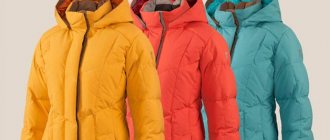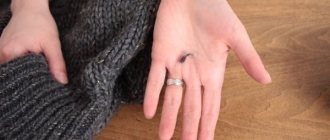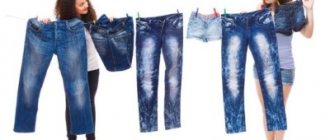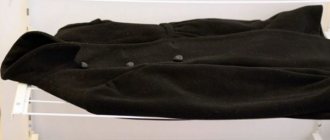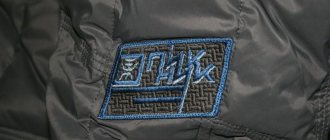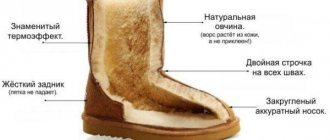The end of the winter season is the time to put your warm clothes in order. Its most popular type is down jackets and padding polyester jackets. With the onset of spring, washing and drying down jackets becomes important. Despite its apparent simplicity, this procedure requires some knowledge: with them, a fashionable warm jacket will not lose its attractiveness and will last for several more seasons.
Basic rules for drying down jackets
The issue of care should be raised at the time of purchase. This is when you need to carefully study the manufacturer’s requirements and recommendations. If the label does not prohibit it, the jacket can be washed at home. As a rule, there are no problems with water procedures, but the question of how to dry a down jacket after washing at home worries many.
Drying items with down filling is not easy. Failure to follow some rules can lead to many troubles: loss of attractive appearance and warming properties.
This happens when drying for too long or when exposed to excessive heat. Down and feathers react very sensitively to excess hot air: therefore, it is better to avoid drying a down jacket on a radiator or electric heater. Our task is to figure out what the right thing to do is to not delay or force the process, while preserving beauty and warmth for future seasons. The rules are:
- clothes with down filling should be dried in a vertical position, preferably on a hanger, so that there are no dents left from clothespins;
- all zippers must be fastened - in this position the jacket will quickly take the desired shape;
- Pockets must be turned outward for better drying.
From time to time, shaking is not only necessary, but also necessary: this way the already dried filler inside will fluff up and take up free space, separating from the still wet one.
How to wash a padding polyester jacket
Laundry detergent is very important. For such clothes, choose liquid products for delicate fabrics. No powder is used. Why? It is very difficult to wash, so the item may become covered with white stains. If you washed it with powder and saw white spots, then run it through the machine again without adding any products.
You should study the composition of the detergent; there should be no bleaches or stain removers, as they destroy the padding polyester.
You can wash a winter jacket only 2-3 times per season. If ironing is required, you can iron it through gauze or use a steamer.
Types of drying clothes
In order not to provoke the formation of lumps and an unpleasant odor, the down jacket must be dried quickly. The first thing that comes to mind is to ensure an intensive supply of hot air to the jacket. An oven, a battery, and a convector are used. However, these methods will only do harm. Winter clothing should be kept away from sources of hot air. It negatively affects the condition of the down filling and the shape of the product.
Horizontal drying
The most common way is to place the jacket on the dryer after washing and let it dry quietly. This is quite acceptable, but not enough.
- First you need to wait until the excess water drains. It is better not to twist the product with your hands, so as not to damage the delicate structure of the down.
- Then you need to carefully feel the down jacket with your fingers and disassemble all the lumps formed after washing, as well as straighten the folds and cells. A straightened product dries faster.
- Periodically, the down jacket needs to be actively shaken, turned over from the front to the wrong side and back.
The more often the down jacket is fluffed and tossed with force, the better and faster it will dry with minimal consequences.
Vertical
Vertical drying is the most correct. It guarantees a high-quality result subject to certain conditions:
- The room should be warm and dry.
- There should be no direct sources of hot air nearby.
- It is better to place the product on a hanger.
- All zippers and buttons must be fastened.
- Pockets must be turned inside out.
- Shake clothing periodically to distribute fluff evenly.
Following these simple rules will allow you to dry your down jacket quickly and safely.
How to quickly dry a down jacket
A negative feature of all down products is the long drying time. A down jacket won't dry in one day, but if you don't have a replacement in your wardrobe, you can speed up the process. It is often not recommended to resort to these methods, but you can try it once.
Fan
If the situation requires it, the down jacket can be dried with a fan. It must be placed at a distance of 1-1.5 meters from the product and ensure the mobility of the head. When moving, air flows will blow on the product from different sides and provide better ventilation. Drying carried out in this way will significantly speed up the process.
Hairdryer
To avoid streaks, you can try drying your down jacket with a hairdryer. The device should operate at a minimum temperature, and it is better to keep it at a distance of at least 20 cm from the product. In addition, you need to remember:
- In this way, the jacket must be dried from the wrong side;
- the item must be in an upright position on hangers;
- During the drying process, the product must be shaken by hand.
Since the operating mode of the hair dryer must be selected to the minimum, a quick result cannot be achieved this way. If you set the power to high, the jet of hot air can damage the filler and outer fabric.
Dryer
You can dry your down jacket quickly, efficiently and safely in a dryer. If the washing machine has a similar function, you can also use it. The main thing is to make sure that the down and feathers are not knocked out, otherwise the centrifuge will leave the jacket completely without filler.
To use the dryer you need a little:
- Select low speed mode.
- Beat the product thoroughly after drying. To avoid the formation of lumps, additional balls can be placed in the drum.
Automatic drying gives excellent results. It leaves no streaks or musty smell, and you can put the product on the same day.
Vacuum cleaner
An effective way is to dry it using a vacuum cleaner with a reverse blow function. This method is suitable for high-quality drying of an already dried product.
- the jacket or coat must be placed in a large bag, preferably in a vacuum bag (for storage);
- deflate the air;
- make a hole according to the diameter of the hose;
- insert the vacuum cleaner pipe and turn on the blowing mode.
The pressure of warm air will effectively remove residual moisture, fluff the filler and add fluffiness to the product.
A hairdryer is rather an exception to the rule. You should not resort to it too often. It is important to keep a distance so as not to damage the fabric and down.
Other options
Many people dry small items on heating radiators. Ordinary things can withstand this procedure without problems, but down jackets often get damaged. The filler reacts very poorly to high temperatures and eventually cakes.
However, nothing prevents you from placing a folding drying rack with a warm jacket just next to the radiator. Moderate heat, coupled with the convection movement of air masses, seriously speeds up the process without the risk of damaging the product. This method, combined with a conventional fan, is the safest and most effective.
Summer jackets made from natural fabrics can be dried in the oven, but only if there is a fan in it. The procedure here is as follows: • place the item on a baking sheet covered with foil; • include convection and heating (no more than 60 degrees); • the jacket is periodically turned over.
For delicate fabrics, another method is used: • the item is placed on the back of a chair; • the oven door is opened; • set the temperature to +150 °C; • turn on the airflow.
Which drying method to choose
You should always dry your down jacket correctly after washing, regardless of how it was cleaned - by hand or in the washing machine.
After hand wash
Washing a down jacket by hand is not the best solution. But if it is not possible to use a washing machine, a manual procedure is acceptable. The main difficulty is to rinse the product thoroughly to avoid streaks and whitish spots on the surface. Only after the detergent is completely removed is the jacket sent to dry.
If the procedure is carried out in winter, it is necessary to thoroughly wring out the product and ensure warmth in the room. After hand washing, a lot of water remains inside, and low temperatures will cause the down to rot and create an unpleasant odor.
It is better to dry a hand-washed down jacket in a horizontal position, ensuring full air access. It is also necessary to knead the product thoroughly to avoid lumps.
After machine washing
Washing in a washing machine guarantees better rinsing than washing by hand. Modern machines allow you to avoid the accumulation of detergents in the fabric and filling, and the product will be streak-free after drying.
To properly dry a down jacket after machine washing, you must adhere to the basic rules. Then by the next winter season the jacket will be like new.
Helper balls
Many housewives don’t even realize how much help spiked balls can provide. Before putting your jacket into the machine, load it with 5-6 lightweight plastic spiked balls. They are bought for dog games. When they bounce off the walls of the drum, they will break up lumps well and knock out dirt, even better than when washing by hand.
Benefits of the ball process:
- products wash better;
- the expenditure of funds is reduced;
- white stains practically do not appear;
- things dry quickly.
Features of drying down jackets of different models
The variety of winter outerwear today is very large. The choice depends on taste, budget, lifestyle. To extend the life of any wardrobe item, it needs to be cleaned or washed. Dry cleaning allows you to pick up a product that is ready for storage, while self-washing leaves behind the question of how to quickly dry the jacket so that it can be packed away during the summer heat.
Quilted
Different models require some subtleties of care. Quilted down jackets with stitched inner tubes are best dried vertically. The seams securely fix the filler inside each compartment and prevent the fluff from bunching up into one big lump. To prevent the jacket from drying for too long, place it on a hanger in a well-ventilated, warm room.
Unquilted
A down jacket without quilting is distinguished by the fact that the filling inside it is not fixed in any way. This is why such a product needs to be dried in a horizontal position: wet down will not fall down the jacket.
Periodically, the coat should be fluffed with your hands to better distribute the dried insulation, and after the clothes are completely dry, fluff them up like a pillow.
What to do with stains on a jacket
It is important to deal with them before washing with products that do not damage the structure of the clothing. This is done so that after washing you do not get a color change in the dirty areas.
Girls often end up with lipstick marks. Lipstick can be easily cleaned with rubbing alcohol. Traces of foundation or lip gloss can be removed with toothpaste. Grease stains can be removed with dishwashing detergent. Traces of blood are washed away with laundry soap. Carry out the treatment with a soft sponge or brush.
If outerwear is made of suede or membrane material, then only hand washing is required. If the hood has headphones built in, take the clothes to the dry cleaner.
How to dry different materials
During the cold season we wear different clothes. Some people prefer down, while others prefer padding polyester. Some companies skillfully combine the thermal conductivity of natural insulation and membrane fabrics. The mode of washing and drying products made from different materials is not much different.
Many people are concerned about the question of whether it is possible to dry winter clothes in the cold. This is allowed, but subject to a mandatory condition: it is necessary to alternate between cold air and a warm room. A down jacket dried in this way will smell fresh.
Down and wool
Unlike wool sweaters, which are traditionally dried in terry towels, a down jacket does not tolerate this method. The humid environment that forms inside the fabric leads to delayed drying and even the formation of mold. You need to dry such clothes without additional layers of fabric, then the jacket will not have an unpleasant odor.
Sintepon
With artificial insulation, jackets have the same properties as down jackets: they are light, warm, and soft. Caring for them is also no different:
- They can be washed in a machine using rinsing and spinning;
- It is necessary to dry products on padding polyester in a warm room with access to fresh air.
If you follow these recommendations, the synthetic winterizer will not stick together, and the coat will not lose its properties.
Membrane fabrics
If a down jacket combines natural insulation and modern technology, you don’t need to be afraid to wash it. To properly dry such a product, it is enough to follow the general tips for washing down jackets:
- the membrane, like down, does not like hot air and heating appliances;
- Membrane fabrics dry vertically;
- Drying in a special machine is permissible.
Synthetic winterizer is similar in its properties to down filling: if you have any doubts about washing and drying it, it is better to follow the general rules for caring for down jackets.
Preparation
Before the process, the jacket is prepared.
- If there is a collar with fur, unfasten it. Remove any fur inserts. Turn the jacket inside out and fasten it completely with buttons or a zipper. Take keys, money out of your pockets - anything that can tear it during the washing process.
- Place the product in a special bag or mesh for washing if you intend to use a washing machine. This way the jacket will retain its shape as much as possible.
Useful tips
It happens that after following all the recommendations for washing a down jacket and drying it after it, undesirable consequences still appear. These include yellow or white spots, lumps, and voids. In this case, you need to remember whether everything was done correctly.
What not to do when drying
To maintain the optimal service life of winter clothing, it is strictly not recommended:
- Use a damp and cold room for drying. The fluff may turn sour, causing mold and an unpleasant odor.
- Hang hangers near an open fire. This violates general safety rules and may cause clothing to melt or catch fire.
- Dry the product on the radiator. This threatens stains and damage to the structure of the insulation.
- Place the down jacket near sources of hot air: convectors, fan heaters, oil heaters.
Each of the prohibitions is categorical: such treatment will lead to the unsuitability of winter clothing.
How to avoid lumps
Drying a down jacket after washing without lumps is, oddly enough, a doable task. You can take care of this before washing. It is enough to place several special or regular tennis balls in the drum. If this was not done during washing, then this method can be resorted to while drying in a special machine.
If you don’t have any balls on hand, regularly beating the jacket during the drying process will help get rid of lumps. It will ensure uniform distribution of insulation inside.
The appearance of streaks after washing
Stains on clothes are a common problem. They come in two types:
- White is the result of detergents drying out due to insufficient rinsing.
- Yellow, especially on white jackets, which appears as a result of drying in direct sunlight. Another possible reason is the natural release of oil from down or feathers.
Both types of stains disappear after thorough rinsing and when washing with liquid delicate detergents.
What not to do
There are many life hacks for extra-drying outerwear. Some of them have a detrimental effect on:
- raincoat fabric;
- filler;
- lining;
- knitted tie on the sleeves.
What you should not do when drying down jackets:
- Place the jacket on the radiator. At the point of contact of the product with the heated surface, streaks will appear, and the fluff will appear in clumps. Drying down jackets on very hot radiators causes the color of the raincoat fabric to change.
- Use oil heaters. Due to the heating of the metal, the synthetic packing begins to melt, which leads to deformation of the product and a deterioration in its heat-insulating properties.
- Dry the product next to an open fire. The method really combats excess moisture. But it threatens to melt synthetic materials. Therefore, you should not dry your coat or jacket near a gas stove, fireplace or stove.
- Hang a down jacket on the balcony in wet weather. You cannot dry jackets on unheated balconies in late autumn. You won’t remove moisture, but you will get the smell of dampness and mold.
- Wring out the down jacket at high drum speeds. Due to the high centrifugal force, the filler will collect in one place on the lining. In 95% of cases, jackets do not survive such crash tests.
- Dry your coat in the sun. Under the influence of UV rays, the lining and raincoat fabric fade unevenly.
Before throwing your down jacket into the washing machine, pay attention to the symbols on the label. The icon of a crossed out basin with water indicates that the item is intended for dry cleaning only. This means that you will have to take the down jacket to the dry cleaner or remove dirt with a steam cleaner.
How to fix mistakes
If, after drying at home, it was not possible to avoid matted fluff or stains, you can try to fix everything:
- Disassemble the lump manually - take it with your hands from both sides of the product and carefully stretch it in different directions. Afterwards, you need to leave the jacket for a while for additional drying, because the fluff inside may be damp.
- Stains can be washed away with a sponge. If this method turns out to be ineffective, it is better to wash the product or rinse it additionally in the washing machine and dry it according to all the rules.
Handwash
How to wash a jacket on padding polyester by hand:
- Fill the bath with water no hotter than 50 degrees. Thoroughly dilute the detergent. Bleach should not be used.
- Place the item in water and knead it with light movements so that the filler does not get lost. Wash stains with soap and a foam sponge. You cannot soak the product, because the padding polyester will deteriorate.
- Drain the water and add new water. Rinse the jacket and drain the water. Repeat several times until the water is no longer soapy.
- Squeeze by hand: Gently squeeze the moisture out with your palms throughout the entire product. Hang the jacket over the bathtub so that the main water drains away.
- Place the item on a horizontal surface, straighten it and leave until dry. It is recommended to place a terry towel.
How to care for a down jacket
A high-quality down jacket is not cheap. In order not to damage your budget, you need to learn how to properly care for it. This doesn't just apply to washing and drying.
If the contamination is only in a certain area, it can be washed by hand with a sponge using a soap solution. This will help get rid of dirt and preserve the appearance of the product. Frequently washing a down jacket is not good for it.
When putting away your down jacket until next winter, it is better to place it on a hanger and cover it with a cover. Folding for a long period of time can lead to creases in the fabric and matted fluff.
Drying a down jacket at home may seem labor-intensive, but it significantly reduces costs and saves the family budget.
What not to do
The desire to dry wet things very quickly can cause rash actions. The following three methods should not be used, even if you are in a hurry.
- Electric heater. The high temperature of the surface of the device can cause damage to clothing. In addition, contact of moisture with electricity can cause a short circuit.
- Open fire. If you get your things wet while hiking, give up the idea of drying them over a fire. Products must be located no less than a meter from the fire source. This also applies to gas burners.
- Hair straightener. The device can irreparably damage things, leaving brown marks or melted fibers on the fabric.
Having remembered a couple of ways to quickly dry things, you will feel more confident and will face all troubles of this kind with honor. But these methods are best left as a last resort, because emergency drying does not have the best effect on the condition of the fabric and can even cause damage to the clothes. Therefore, try to wash and dry items in a timely manner. When planning an outfit for some important event, think about two options. This way, you will have some kind of plan “B” in case of force majeure.

